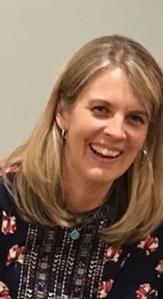Executive Art Director Ann Stott and Assistant Art Director Heather McGee talk shop and tiger stripes.

|
|
| Ann Stott | |
How did the two of you work together to come up with a new look? What was your goal?
Ann: We both have advertising backgrounds, so we worked together on a brief that established the design parameters and identified what elements should visually drive the new covers. We did this by surveying the sales and marketing team, as well as gathering information from the editor and the author. We looked at the competition and how these series were being positioned in the marketplace. From there we identified what we wanted to keep from the original design and what we wanted to change. Our main goal was to reinvent the playful spirit of the series and to capture Judy's spunk and determination through the use of more color and updated typography. We each worked up a number of different directions, and over several months of iterations we narrowed it down to our top two. Picking up the tiger-stripe pattern from Judy's leggings and incorporating it into the design was a breakthrough. We thought it made the perfect "Judy" statement and held the entire series together.
Heather: We brainstormed together a lot, looking at competitors' books as well as kid trends and what kids are wearing. Today's kids are very fashion-oriented, so we took another look at Judy's wardrobe to see if we could find some inspiration there. Her tiger-stripe pajama pants and "I ATE A SHARK" T-shirt from the first book are pretty unforgettable, so that sparked the idea of using the tiger print. We have slowly been introducing color to Judy, too, so it seemed a natural fit to utilize the tiger print in various Judy colors. Our goal was to have an eye-catching look that existing and new readers would want to grab to learn more about Judy.
 |
|
| Heather McGee | |
What are some changes we'll see in the new design of the series?
Ann: The color palette is much brighter, and we've replaced the brown kraft-paper background with a Judy Moody signature tiger-stripe pattern. Megan's name is featured prominently across the top, and we've included catchphrases to bring Judy's voice to each cover. The main art is much larger and features a more active image. The display type was updated with a modern, sans serif font, and we've added more color and design elements to the spines to help differentiate each title.
Heather: We were able to utilize a lot of the existing artwork with a few new pieces by Peter, but rather than focus on Judy's face, we brought forward the artwork that shows more movement. Our last refresh of Judy included only eight books--this one is 13 books with more on the way! Trying to make each book unique while staying within the overall look of Judy tested our design skills.
How has branding for kids' book series changed in the past 20 years?
Ann: Children have become much more visually sophisticated. When the first Judy Moody book came out, most illustrated fiction had the same look: full-color cover art and traditional type design. Back then we wanted the Judy Moody series to stand out from what was on the shelf. Twenty years later, young readers are even more aware of brands. They know what they like and what they don't. Nothing stays the same for long in their worlds. They are used to change, and we have to find ways to capture their attention.
Heather: Branding is much more competitive nowadays; there are so many choices for kids. It's imperative to have an eye-catching design that doesn't look too similar to all the other books that can carry across many covers. Because of this competitive nature, brand refreshes seem to occur much more frequently, and it's sometimes challenging for a designer to come up with a new look that is still true to the brand, yet remains unique.

